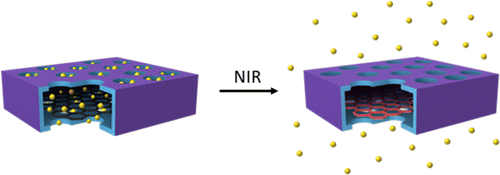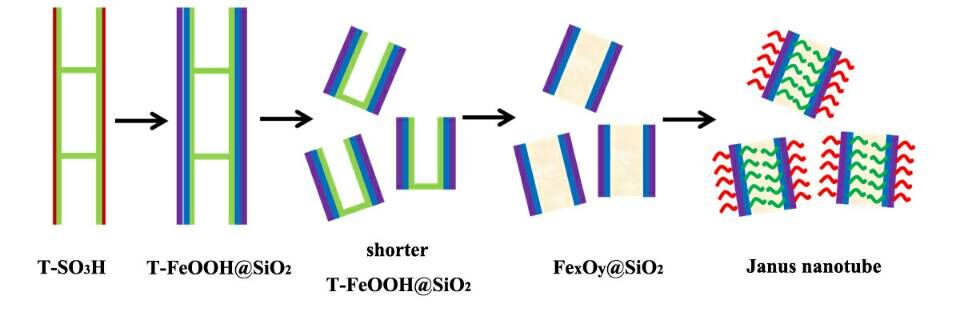 2016年论文
2016年论文
1. R. H. Deng, H. Li, J. T. Zhu*, B. H. Li*, F. X. Liang, F. Jia, X. Z. Qu, Z. Z. Yang*, "Janus Nanoparticles of Block Copolymers by Emulsion Solvent Evaporation Induced Assembly", Macromolecules, 2016, 49, 1362–1368.
We present a facile approach toward straightforward synthesis of Janus nanoparticles (NPs) of poly(4-vinylpyridine)-based block copolymers by solvent evaporation induced assembly within emulsion droplets. Formation of the Janus NPs is arisen from the synergistic effect between solvent selectivity and interfacial selectivity. This method is robust without the requisites of narrow molecular weight distribution and specific range of block fraction of the copolymers. Janus NPs can also be achieved from mixtures of copolymers, whose aspect size ratio and thus Janus balance are finely tunable. The Janus NPs are capable to self-assemble into ordered superstructures either onto substrates or in dispersions, whose morphology relies on Janus balance.
2. L. Tang, S. N. Yang, F. X. Liang*, Q. Wang, X. Z. Qu, Z. Z. Yang*, "Janus Nanocage toward Platelet Delivery", ACS Appl. Mater. Interfaces, 2016, 8, 12056–12062.
The platelet-shaped Janus nanocages with a mesoporous silica shell are prepared. PEG moiety onto the exterior surface is responsible for good dispersity in water. The graphene sheet inside the cavity is responsible for hydrophobic performance to selectively capture hydrophobic species, and photothermal effect by NIR irradiation. As a biocompatible DOX-loaded Janus platelet delivery, HeLa cell cytotoxicity is greatly enhanced under NIR irradiation. There exists a synergetic effect between the chemotherapy and photothermal therapy.
3. Y. Chen, Z. Liu, X. Z. Qu, F. X. Liang*, Z. Z. Yang*, "Janus Composite Nanotubes", Chem. Asian J. 2016, 11, 1785-1788.
We propose a facile method to achieve paramagnetic Janus nanotubes with two compositions compartmentalized onto the interior and exterior surfaces, respectively. A sulfonated polydivinylbenzene (PDVB) nanotube is prepared by simple sulfonation of the exterior surface of a PDVB nanotube. Silica@FeOOH dual layers are sequentially grown onto the sulfonated PDVB nanotube surface. The composite nanotubes become paramagnetic after calcination and can be broken into shorter pieces under vigorous ultrasonication. After selective modification of the interior and exterior surfaces of the paramagnetic nanotubes, the nanotube shell becomes Janus in wettability. Desired hydrophobic species can be selectively captured inside the cavity. The paramagnetic Janus composite nanotubes can align into parallel chains under a magnetic field, which is self-disassembled upon removal of the magnetic field.
4. W. Cui, R. Liu, H. Q. Jin, P. Lv, Y. Y. Sun, X. Men, S. N. Yang, X. Z. Qu, Z. Z. Yang, Y. N. Huang*, "pH Gradient Difference around Ischemic Brain Tissue Can Serve as a Trigger for Delivering Polyethylene Glycol-conjugated Urokinase Nanogels", J. Control. Release, 2016, 225, 53–63.
pH-sensitive polyethylene glycol-conjugated urokinase nanogels (PEG-UKs) were previously reported to be a new form of UK nanogels that could release UK at certain pH values. In this study, we evaluated the effect of PEG-UK targeted to ischemic tissue with microcirculation failure in rat model of ischemic stroke and investigated the possible mechanisms of action.
5. F. Jia, F. X. Liang, Z. Z. Yang*, "Janus Mesoporous Nanodisc from Gelable Triblock Copolymer", ACS Macro Lett. 2016, 5, 1344-1347.
The polymer/inorganic composite trilayered Janus mesoporous nanodiscs are synthesized by coassembly of gelable poly(ethylene oxide)-block-poly(3-triethoxysilylpropyl methacrylate)-block-polystyrene (PEO-b-PTEPM-b-PS) and PEO-b-PS via a sol−gel process at an emulsion interface. Bimodal phase separations are responsible for the formation of isolated nanodiscs and mesopores within the discs. The Janus mesoporous nanodiscs are amphiphilic to form superstructures in dispersions. They can serve as a solid surfactant to stabilize emulsions.
6. X. H. Yao, J. Y. Jing, F. X. Liang, Z. Z. Yang*, "Polymer-Fe3O4 Composite Janus Nanoparticles", Macromolecules, 2016, 49, 9618–9625.
A Fe3O4 nanoparticle (NP) based on composite Janus NP with single polymer chain is prepared by termination of the modified Fe3O4 NP with the anionic living polymer chain. The requisite that the polymer chain should be sufficiently large over the NP diameter determines the grafting of single polymer chain. From the opposite side of the NP surface, functional species can be selectively grown for example grafting responsive PNIPAM by ATRP. Besides simple combination of the thermal and magnetic responsive performances of different components, the PS-Fe3O4-PNIPAM composite Janus NP shows additional interactive performance such as NIR triggered Janus/hydrophobic transition at low surrounding temperature below LCST~32 °C.
7. H. Zhang, Q. Wang*, B. Y. Jiang, F. X. Liang, Z. Z. Yang*, "Coral-like Janus Porous Spheres'', ACS Appl. Mater. Interfaces, 2016, 8, 33250–33255.
A Janus porous sphere with a coral-like microstructure is prepared by stepwise dealloying a metallic alloy sphere and sequential modification (for example, using silanes and polymers). Nanoscale coral-like microstructure of the internal skeleton gives remarkable capillary force, thus accelerating the mass transportation. Starting from the outer layer of the sphere, stepwise dealloying can achieve different layers inwardly, thus introducing different composition and performance. As an example, poly(ethylene glycol)−poly(N-isopropylacrylamide (PEG−PNIPAM)- and poly(ethylene glycol)−poly(N,N-diethylamino-2-ethylmethacrylate) (PEG−PDEAEMA)-responsive Janus porous spheres can quickly capture oil by simply changing temperature or pH. Similarly, release is also triggered.
8. S. N. Yang, F. Y. Zhu, Q. Wang, F. X. Liang, X. Z. Qu*, Z. H. Gan*, Z. Z. Yang*, "Nano-rods of doxorubicin with poly(L-glutamic acid) as a carrier-free formulation for intratumoral cancer treatment", J. Mater. Chem. B, 2016,4, 7283-7292 .
In addition to intravenous injections (i.v.), topical dosing of doxorubicin hydrochloride (DOX) has also been the
focus of cancer treatment recently, although it normally requires well-designed drug carriers. In this work, we found that DOX could form fibril-shaped DOX aggregates via self-assembly in phosphate buffer (PB) and then co-assemble with poly(L-glutamic acid) (PGA) at a proper polymer–drug ratio, giving a unique nano-rod-shaped microstructure. The release rate of DOX from the PGA/DOX nano-rods was thus easily controlled at a slower release rate without being encapsulated by any classic carrier. In vitro cell culture demonstrated that the PGA/DOX nano-rods were not favorably taken up by cancer cells, which can be attributed to the negatively charged nature and the non-spherical shape of the aggregates. These features suggest great potential for the PGA/DOX assemblies for a sustained delivery through the intratumoral pathway (i.t.) as a carrier-free formulation. In the mouse model it diminished organ damage at a dose level of 30 mg kg−1via i.t. injections compared to the serious cardiotoxicity and renal toxicity via typical multiple i.v. dosage of free drug solution at 5 mg kg−1. As a result, the PGA/DOX formulation showed efficient anti-tumor activity. The survival rate of tumor bearing mice was significantly increased by over 35% compared to the i.v. injections of DOX solutions. Therefore, PGA/DOX nano-rods may provide a new and safe delivery route of the common anti-tumor drug.
9. 梁福鑫, 刘冰, 杨振忠*, "Janus复合材料", 高分子通报, 2016, 9, 45-51.
Janus复合材料基本特征在于其微尺度空间具有明确分区的化学和功能。关键问题在于发展新方法,精确控制形貌、微结构、和表面化学和功能严格分区。本文主要总结了本课题组的有关点滴成果,指出了存在的重要问题及发展方向,展望了近期有望突破领域。







